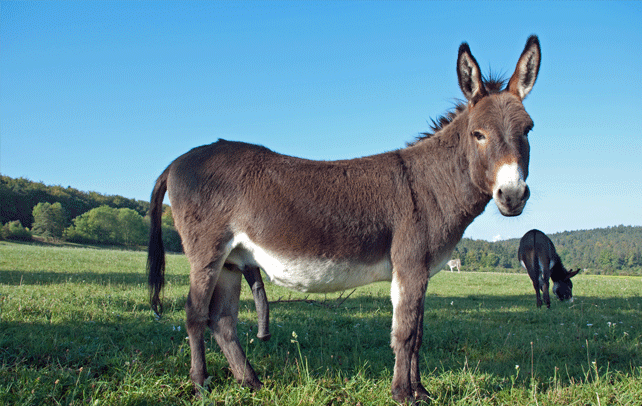Information About Mules

Mule is a hybrid produced when a male donkey (jack) mates with a female horse (mare). A mule is unable to reproduce naturally because of its irregular chromosome count. Since 1500s, there have been very few exceptions where the female mules have produced foal by mating with a jack or a stallion. Mules are present in any part of the world where there is inhabitation of donkeys and horses. Mules are very useful animals and do almost all the kinds of jobs that a horse does. Their physical attributes and behaviour depend on the breed of mare and jack. Mules succeed in having all the characteristics that a horse possesses. The tolerance, sure footedness, intelligence, and drought endurance of the donkey combined with the agility, body structure, power, and nerve of the horse, makes mule an excellent working domestic animal. Handlers of working animals prefer mules over horses most of the time because mules have harder skin which is less susceptible to extreme heat or rain. A mule’s hooves are more protected from diseases and insects, and are much tougher than that of a horse.
Fast Facts
Scientific Name: Equus Mule
Kingdom: Animalia
Phylum: Chordata
Class: Mammalia
Order: Perissodactyla
Family: Equidae
Genus: Equus
Species: E. caballus + E. asinus
Weight: 370 to 460 kg
Lifespan: 30 to 50 years
Diet: Herbivorous
Size: 1.2 to 1.5m (47 to 59in)
Top Speed: 24 km/h (15 mph)
Conservation Status: Least concern
Color: Grey, brown, black
Skin Type: Fur
Habitat: Arid forests and deserts
Average Litter Size: 0
Predators: Fox, wolf, lion
Special Features: Stocky body and long snout and ears
Interesting And Fun Facts About Mules
- The mule inherits many attributes of its parents that include body structure, neck, teeth resembling that of a horse, small hooves, short mane, thin limb, and thick head like that of a donkey.
- Along with appearance, the mule shares the traits of being sturdy, agile, and powerful like horse; and at the same time, tolerant, patient, and temperate like a donkey.
- The pelage of a mule is quite similar to that of a horse. Mules are found in varied colours, like black, brown, grey, copper-red (sorrel), and reddish-brown (bay) while colours like white, palomino, buckskin, roans, and dun are very rare.
- Mules having the same body size like that of a horse eat less fodder than horse.
- A mule can carry up to 20% of its weight when it comes to goods. However, they can carry upt o 30% in case a rider is mounted on them.
- Mules meant for racing are produced from thoroughbred mares while the ones used for long trails are produced from quarter horse.
- A mule can be differentiated from a donkey by looking at its tail that is hairy till the top like a horse’s tail whereas a donkey’s tail has a tuft on the tip like that of a cow.
- All the mules are born infertile. However, hinnies, the female breed of mules, have been known to reproduce if they mate with donkey or horse of pure breed.
- Mules can kick with its hooves in any direction, including sideways.
- Compared to its parents, a mule shows much more reasonable thinking with curiosity with a good sense of self-preservation and often it has been noted that it doesn’t lead its rider forward if it senses danger.
- Mules are intelligent creatures and no one, including human beings can easily trick them.
- Mules produced from the appaloosa breed of mare inherit the distinctive varied pattern of spots from them.
- The sounds created by mules are a combination of those produced by its parents. It cries like a donkey while its whining sounds like that of a horse.
- Mules have a longer life span than that of a horse. A horse lives upto 15 years while the farm bred mule has the ability to survive upto 18 years.
- The large-sized draft mule is produced by breeding draft horses, like the Belgian horses with mammoth jacks.
- Draft mules have the combined characteristics of a draft horse’s power and jack’s endurance.
- More than 60 birth cases of foals have been recorded since 1527, for instance, in 1984, a foal was reported in China; in 2002, another foal was produced in Mexico; and in 2007, a foal was born to a mule named Kate in Colorado.
- In the 18th century, George Washington, the first president of the US, started the breeding of great American Mammoth Jacks with catalan donkeys, a gift from the king of Spain.
- Due to increase in industrialization, the usage of mules for agricultural purposes and transportation declined and got replaced by tractors and trucks in the mid of 20th century.
- Although the rise of industrialization reduced their demand but many breeders in the US continued breeding mules as a hobby.
- The modern saddles mules have been produced by utilizing a better breed of mares in the US.
- Mules are also used for exhibition and entertainment purposes. The mule enthusiasts make them participate in various competitions; such as, English pleasure riding, dressage, and show jumping.
- Commercial pack mules are used in mountainous areas and the areas with rugged roads to transport goods. The Sierra Nevada region of the US has sixteen commercial mule pack stations.
- The army of the United States used mules to carry arms and ammunitions over the rugged terrains of Afghanistan during the soviet wars.
- The US forces have created Mountain Warfare Training Centre in the Sierra Nevada region to train the animal packers. The training session is conducted for 11 days.
- Idaho Gem, a mule clone, was produced as a part of project Idaho in the year 2003 by the researchers at University of Idaho and Utah State University.
- In 2003, China was ranked as the largest market for mules followed by Mexico and some central and southern American nations.









